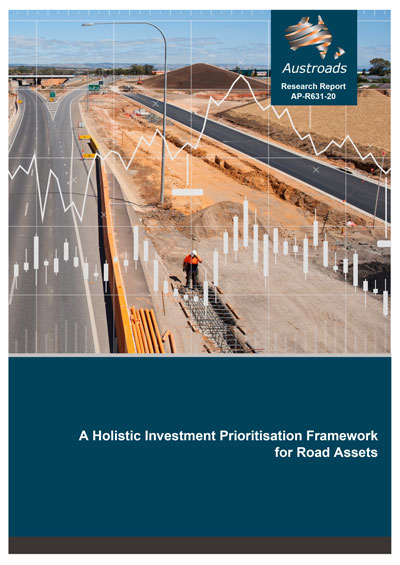Asset Management

- Publication no: AP-R631-20
- ISBN: 978-1-922382-23-8
- Published: 3 September 2020
- PDF (free) Download
This report proposes a holistic and risk based prioritisation framework to support investment decisions across road asset classes and expenditure categories.
Transport agencies currently rely on different decision making frameworks to help identify investment opportunities for the road network. The framework used often depends on the nature of the expenditure. For example, cost benefit analysis is commonly used to assess large capital upgrades and risk assessments are commonly used to identify bridges that need treatment. The outputs produced by the different decision making frameworks are incompatible, making it difficult to prioritise across different expenditure types.
The prioritisation framework supports investment decision making across and within service groups, asset classes and expenditure categories. The framework also seeks to enhance existing assessment management reporting by providing easy to understand aggregate outputs to help non-technical decision makers make funding decisions.
The Austroads investment prioritisation tool illustrates how to draw upon the outputs of the decision-making processes of road authorities to enable a like-for-like comparison of different investments. In general, the investment prioritisation tool compares various user defined scenarios to compare and contrast the investments undertaken in each scenario. Download the Excel Tool.
- Summary
- 1. Introduction
- 1.1 The importance of having a well-functioning road network
- 1.2 The purpose of this project
- 1.3 What you will find in the remainder of this report
- 2. The proposed investment framework
- 2.1 Overview of common decision making frameworks
- 2.2 The proposed framework
- 2.3 Considerations when applying the framework
- 2.3.1 Projects that are non-discretionary
- 2.3.2 Treatment of minor expenditure items and programs of work
- 2.3.3 The need for a broader framework
- 2.3.4 The selection of metrics
- 3. An example of how to apply the framework
- 3.1 The hypothetical road authority
- 3.2 Step 1: evaluate individual investments against selected metrics
- 3.2.1 Approach used for risk assessment
- 3.2.2 Approach used for cost benefit analysis/estimating fatalities avoided
- 3.2.3 Approach used for condition modelling
- 3.2.4 Example one: evaluation of additional maintenance funding for sealed roads
- 3.2.5 Example two: Bridges and structures
- 3.2.6 Example three: Traffic facilities
- 3.3 Step 2: Setting investment criteria and determining the optimal portfolio
- 3.3.1 The investment opportunity available
- 3.3.2 Decision making criteria
- 3.3.3 Example one: maximise the net benefit achieved by the portfolio
- 3.3.4 Example two: maximising net benefit subject to meeting safety outcomes and risk appetite
- 4. Further work to enhance the framework
- 4.1 Making the framework practical
- 4.2 There is a need for a broader framework
- 4.3 Gaps in the existing literature
- References
- Appendix A Review of decision making frameworks
- A.1 Cost-benefit analysis
- A.1.1 Overview of cost-benefit analysis
- A.1.2 How cost-benefit analysis works
- A.1.3 Informing the decision-making process
- A.1.4 Conclusion
- A.2 Service level based approach
- A.2.1 Overview of service level based approach
- A.2.2 How the service level based approach works
- A.2.3 How it is used to inform decision making and conclusion
- A.3 Risk assessment
- A.3.1 Overview of risk assessments and how it works
- A.3.2 Reporting of risks at an enterprise level
- A.3.3 Conclusion
- A.4 Reactive and frequency based interventions
- A.4.1 Overview of reactive and frequency based intervention and how it works
- A.4.2 Conclusion
- A.1 Cost-benefit analysis
- Appendix B Current practices to cross asset funding allocation
- B.1 Cross asset prioritisation approaches used overseas
- B.1.1 PIARC’s survey of road authorities
- B.1.2 Transport for London’s prioritisation approach
- B.1.3 Washington State Department of Transport’s prioritisation approach
- B.2 Approaches currently used in Australia and New Zealand
- B.2.1 Overview
- B.2.2 DTPI – South Australia
- B.2.3 RMS New South Wales
- B.2.4 NZTA New Zealand
- B.1 Cross asset prioritisation approaches used overseas
- Appendix C Overview of the toolkit
- C.1 Structure of the toolkit
- C.2 Optimising a portfolio using the Solver function
- C.3 Inputs and outputs from the model
